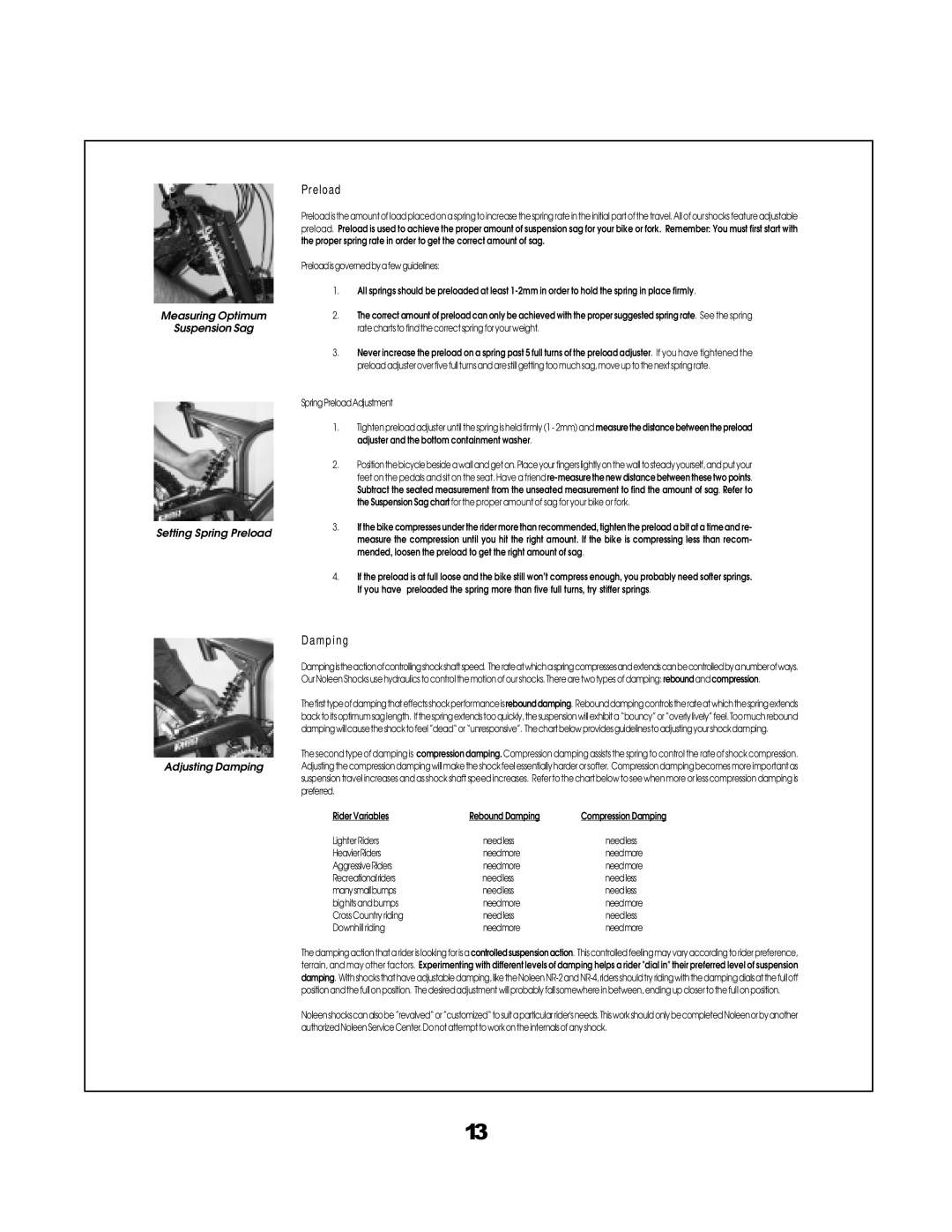
Measuring Optimum
Suspension Sag
Setting Spring Preload
Preload
Preloadistheamountofloadplacedonaspringtoincreasethespringrateintheinitialpartofthetravel.Allofourshocksfeatureadjustable preload. Preload is used to achieve the proper amount of suspension sag for your bike or fork. Remember: You must first start with the proper spring rate in order to get the correct amount of sag.
Preloadisgovernedbyafewguidelines:
1.All springs should be preloaded at least
2.The correct amount of preload can only be achieved with the proper suggested spring rate. See the spring ratechartstofindthecorrectspringforyourweight.
3.Never increase the preload on a spring past 5 full turns of the preload adjuster. If you have tightened the preloadadjusteroverfivefullturnsandarestillgettingtoomuchsag,moveuptothenextspringrate.
SpringPreloadAdjustment
1.Tighten preload adjuster until the spring is held firmly (1 - 2mm) and measure the distance between the preload adjuster and the bottom containment washer.
2.Positionthebicyclebesideawallandgeton.Placeyourfingerslightlyonthewalltosteadyyourself,andputyour feet on the pedals and sit on the seat. Have a
3.If the bike compresses under the rider more than recommended, tighten the preload a bit at a time and re- measure the compression until you hit the right amount. If the bike is compressing less than recom- mended, loosen the preload to get the right amount of sag.
4.If the preload is at full loose and the bike still won’t compress enough, you probably need softer springs. If you have preloaded the spring more than five full turns, try stiffer springs.
D a mp ing
Dampingistheactionofcontrollingshockshaftspeed. Therateatwhichaspringcompressesandextendscanbecontrolledbyanumberofways. OurNoleenShocksusehydraulicstocontrolthemotionofourshocks.Therearetwotypesofdamping:reboundand compression.
Thefirsttypeofdampingthateffectsshockperformanceisrebounddamping. Rebounddampingcontrolstherateatwhichthespringextends backtoitsoptimumsaglength. Ifthespringextendstooquickly,thesuspensionwillexhibita“bouncy”or“overlylively”feel.Toomuchrebound dampingwillcausetheshocktofeel”dead“or“unresponsive”. Thechartbelowprovidesguidelinestoadjustingyourshockdamping.
The second type of damping is compression damping. Compression damping assists the spring to control the rate of shock compression.
Adjusting Damping Adjustingthecompressiondampingwillmaketheshockfeelessentiallyharderorsofter. Compressiondampingbecomesmoreimportantas suspension travel increases and as shock shaft speed increases. Refer to the chart below to see when more or less compression damping is preferred.
Rider Variables | Rebound Damping | Compression Damping |
LighterRiders | needless | needless |
HeavierRiders | needmore | needmore |
AggressiveRiders | needmore | needmore |
Recreationalriders | needless | needless |
manysmallbumps | needless | needless |
bighitsandbumps | needmore | needmore |
CrossCountryriding | needless | needless |
Downhill riding | needmore | needmore |
Thedampingactionthatariderislookingforisacontrolledsuspensionaction. Thiscontrolledfeelingmayvaryaccordingtoriderpreference, terrain, and may other factors. Experimenting with different levels of damping helps a rider "dial in" their preferred level of suspension damping.
Noleenshockscanalsobe”revalved“or”customized“tosuitaparticularrider'sneeds.ThisworkshouldonlybecompletedNoleenorbyanother authorizedNoleenServiceCenter.Donotattempttoworkontheinternalsofanyshock.
13
